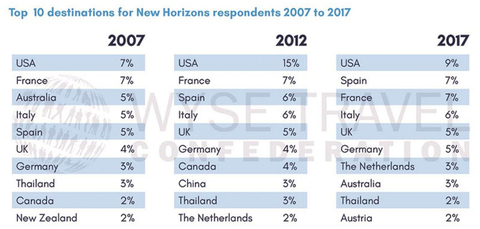From experiential travel to the rise of Gen Z, a new report offers a number of updates on six trends reshaping the travel industry. “New Horizons IV: A global study of the youth and student traveler” is based on the New Horizons Survey, which is conducted by WYSE Travel Confederation every five years. In 2017, the survey attracted more than 57,000 responses from 188 countries and territories. Here are updates on six Millennial and Gen Z travel trends from the report:
1. Travel Splurging
When the New Horizons Survey asked millennial and gen Z travelers what they were willing to splurge on during their trips, they were clear on their preference for experiential purchases. Thirty-seven percent of respondents were willing to shell out extra cash for food and drink experiences. Traditional travel luxuries, such as airfare upgrades, were favored least.
The survey also showed a 26 percent jump from 2012 in the level of activities young travelers undertake while in a destination. Adding unique, one-of-a-kind experiential elements to the basic travel journey might be more productive than trying to develop premium travel products aimed at Millennials, the report suggests.
2. Growing Information Intensity and Utilization of Online Travel Agencies (OTAs)
The number of different information sources used to research the main trip has climbed steadily, from three in 2002 to more than 10 in 2017. Friends and family were still the most used information sources in 2017, but the importance of social media and comparison or referral websites grew significantly from 2012.
More information is being gathered online at the cost of face-to-face interaction or printed information sources. A decade ago, physical travel agent offices took over 70 percent of youth travel bookings – in 2017 much of this business had shifted online, either directly to suppliers or via OTAs.
New media and booking platforms will be crucial travel planning resources for the next generation of youth travelers, Generation Z, according to the report. These digital natives have grown up with smartphones and Wi-Fi and are significantly less likely to use tourist information offices and tour operator brochures. Nearly three-quarters of Gen Z respondents made at least one booking via smartphone in 2017.
3. Top Destinations for Young Travelers
Although the top destinations remain largely the same as in 2012 and 2007, a few noteworthy shifts are revealed from the 2017 New Horizons Survey. While the United States remains the top destination for young travelers, it lost some of its share from 2012. Also, Australia came back into the top 10 for the first time in a decade.

According to the report, young people are still interested to visit the US, but are also deciding to explore other less-visited destinations. Given the slight decline in long trips of 120+ days and an increase in shorter trips, long-haul destinations will need to start rethinking how to attract young travelers undertaking longer stays for study, working holidays, au pairing, and other cultural exchanges.
4. Rise of Digital Nomadism
In 2017, only 0.6 percent of Millennial and Gen Z travelers labelled their travel style as ‘digital nomad’ over more traditional labels such as ‘backpacker’ or ‘traveler’. However, 0.6 percent of all youth travel represents 1.8 million trips.
Digital nomads manage their location independence by making extensive use of Airbnb (56% used on their last main trip). They are the most likely group to book their air travel via computer, smartphone or tablet (85%) and they often use OTAs to book accommodation (55%). Digital nomads are three times as likely to use a co-working space compared with other travelers.
The digital nomad is beginning to transform some destinations, according to the report. More coworking spaces are springing up and high-speed Wi-Fi is a given. Although still small in numbers, digital nomads have an influence on other young travelers through blogging travel and lifestyle advice.
5. The Three Keys to Millennial and Gen Z Traveler Happiness
Millennial and Gen Z travelers indicated three significant factors in their travel happiness: destination, trip length, and activities. Traveler happiness hits fever pitch at one month, however, travelers also reported an uptick in happiness on trips from three to six months’ duration. The 2017 New Horizons Survey found that the more in-destination activities and experiences people have while traveling, the happier they are. Trips to Mexico, Japan, Indonesia and Peru make Millennial and Gen Z travelers the happiest.
6. Generation Z is the Future of Youth Travel
Gen Z is already on track to become the largest generation of consumers by the year 2020. These digital natives are bringing their own flavor to the youth travel market. For example, Generation Z is just as likely as generation Y to make online bookings. However, they use OTAs and third-party websites less. Gen Z travelers are also more social than Millennials and more likely to want to connect with locals.
Related Stories
Stats: 51% of Adults Worldwide Don’t Get Enough Sleep
Top Seven Must-Haves for Today’s Travelers